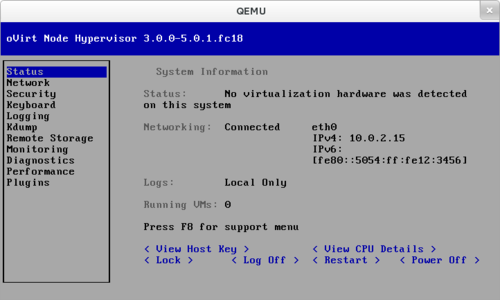oVirt Node 3.0 - or: Fedora read-only
I’ve heard a couple of times that stability is an issue with Fedora because of the never ending stream of updates and generally being a distribution containing bleeding edge software.
In some cases this isn’t really wanted. For some use cases - servers? - you want something stable, something with a working set of packages. Maybe even something which limits the ways of how the system can be modified/configured, to even more reduce the risk of breaking something ™.

oVirt Node is something like this. Traditionally being a slimmed down (<256MB) Fedora (with a read-only rootfs, nothing can be modified) building the ground for VDSM, to act as an hypervisor [0] for oVirt Engine.
Now oVirt 3.0 is about to be released. This is a somewhat major release. One major point of this release is to make oVirt Node more general to decouple it from oVirt Engine remove specific bits (namely VDSM) - to make it more usable and attractive for other projects like Gluster and OpenStack.
Why Gluster and OpenStack - well both projects architectures contain the idea of nodes forming on coherent platform. And as Nodes name says, that is what and that is what oVirt Node targets and what it is good at. Being solid and restricted. Somewhat firmware-like. Node is running of an ISO, residing on a logical volume, files which need to be modified are overlayed (using bind mounts, maybe union-mounts in the distant future). Updates happen by updating that single ISO image. So you’ll always get a tested set of packages through in each new ISO.
So if you might get in to the situation where you need something small, reliable, solid, modifyable (through patches and plugins) and deployable (installable) - via PXE, USB and CD - take a look at oVirt Node.
Besides being more unspecificoVirt Node 3.0 also features a couple of other new and shiny things:
- Support for puppet - You can now configure oVirt Node using puppet
- Support to boot from an iSCSI target
- Support for bonds - You can now create NIC bonds and configure them accordingly
- Better IPv6 support
- Better ways to retrieve diagnostic informations
- A new upgrade tool
- After a new setup UI now also a new installer UI - based on urwid
- Size of the LV holding the ISO was increased from 256MB to 512MB
There will be builds based upon Fedora 18, Fedora 19 and CentOS. Just stay tuned for the official release - which should happen within the next days.
[0] In the widest sense, because KVM is actually the hypervisor.
::: {#footer} [ July 20th, 2013 6:29pm ]{#timestamp} [ovirt]{.tag} [node]{.tag} [fedora]{.tag} [kvm]{.tag} [centos]{.tag} [vdsm]{.tag} [gluster]{.tag} [openstack]{.tag} :::
